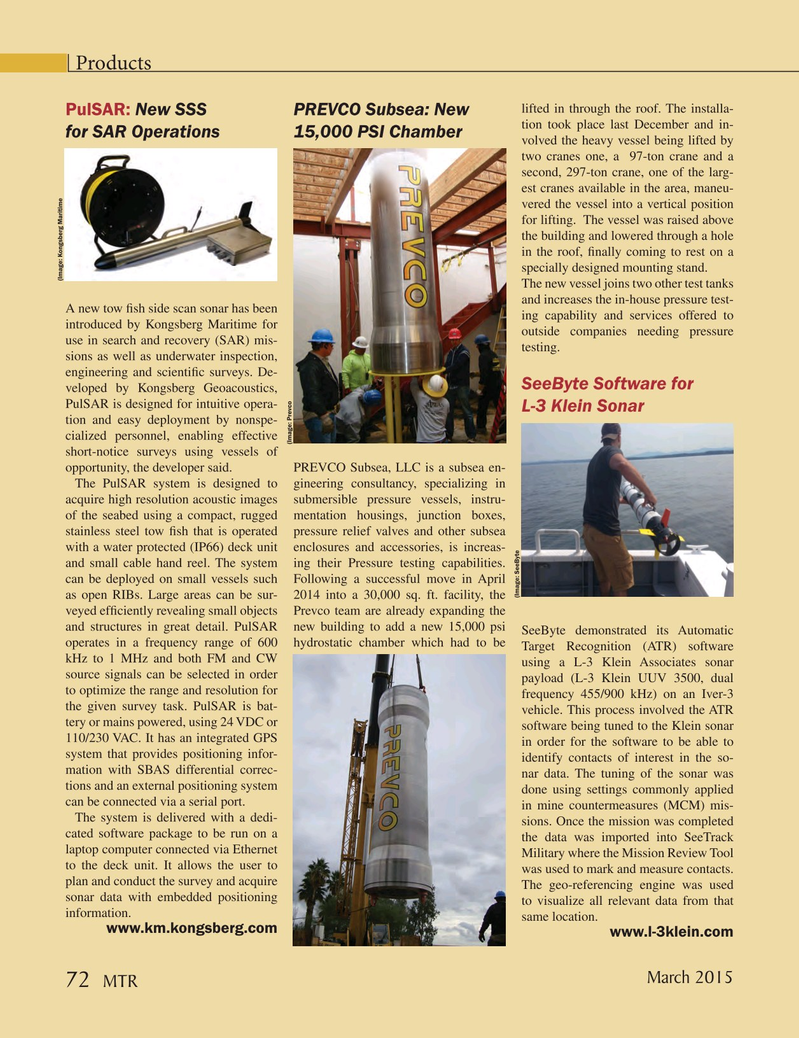
Page 72: of Marine Technology Magazine (March 2015)
Oceanographic Instrumentation: Measurement, Process & Analysis
Read this page in Pdf, Flash or Html5 edition of March 2015 Marine Technology Magazine
Products lifted in through the roof. The installa-
PulSAR: New SSS PREVCO Subsea: New tion took place last December and in- for SAR Operations 15,000 PSI Chamber volved the heavy vessel being lifted by two cranes one, a 97-ton crane and a second, 297-ton crane, one of the larg- est cranes available in the area, maneu- vered the vessel into a vertical position for lifting. The vessel was raised above the building and lowered through a hole in the roof, ? nally coming to rest on a specially designed mounting stand.
(Image: Kongsberg Maritime
The new vessel joins two other test tanks and increases the in-house pressure test-
A new tow ? sh side scan sonar has been ing capability and services offered to introduced by Kongsberg Maritime for outside companies needing pressure use in search and recovery (SAR) mis- testing. sions as well as underwater inspection, engineering and scienti? c surveys. De-
SeeByte Software for veloped by Kongsberg Geoacoustics,
PulSAR is designed for intuitive opera-
L-3 Klein Sonar tion and easy deployment by nonspe- cialized personnel, enabling effective (Image: Prevco short-notice surveys using vessels of opportunity, the developer said. PREVCO Subsea, LLC is a subsea en-
The PulSAR system is designed to gineering consultancy, specializing in acquire high resolution acoustic images submersible pressure vessels, instru- of the seabed using a compact, rugged mentation housings, junction boxes, stainless steel tow ? sh that is operated pressure relief valves and other subsea with a water protected (IP66) deck unit enclosures and accessories, is increas- and small cable hand reel. The system ing their Pressure testing capabilities. can be deployed on small vessels such Following a successful move in April (Image: SeeByte as open RIBs. Large areas can be sur- 2014 into a 30,000 sq. ft. facility, the veyed ef? ciently revealing small objects Prevco team are already expanding the and structures in great detail. PulSAR new building to add a new 15,000 psi SeeByte demonstrated its Automatic operates in a frequency range of 600 hydrostatic chamber which had to be Target Recognition (ATR) software kHz to 1 MHz and both FM and CW using a L-3 Klein Associates sonar source signals can be selected in order payload (L-3 Klein UUV 3500, dual to optimize the range and resolution for frequency 455/900 kHz) on an Iver-3 the given survey task. PulSAR is bat- vehicle. This process involved the ATR tery or mains powered, using 24 VDC or software being tuned to the Klein sonar 110/230 VAC. It has an integrated GPS in order for the software to be able to system that provides positioning infor- identify contacts of interest in the so- mation with SBAS differential correc- nar data. The tuning of the sonar was tions and an external positioning system done using settings commonly applied can be connected via a serial port.
in mine countermeasures (MCM) mis-
The system is delivered with a dedi- sions. Once the mission was completed cated software package to be run on a the data was imported into SeeTrack laptop computer connected via Ethernet
Military where the Mission Review Tool to the deck unit. It allows the user to was used to mark and measure contacts. plan and conduct the survey and acquire
The geo-referencing engine was used sonar data with embedded positioning to visualize all relevant data from that information. same location. www.km.kongsberg.com www.l-3klein.com
March 2015
MTR 72
MTR #2 (66-80).indd 72 MTR #2 (66-80).indd 72 3/8/2015 1:48:23 PM3/8/2015 1:48:23 PM

 71
71

 73
73
